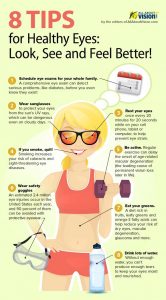 Eye care is a subject close to my heart, being short-sighted for most of my life, and with a genetic family history of short-sightedness.
Eye care is a subject close to my heart, being short-sighted for most of my life, and with a genetic family history of short-sightedness.
 An obsessive reader as a child, eventually my school noticed that I couldn’t see the blackboard, let alone the eye chart, and I got glasses in 4th grade. I graduated to soft contact lenses by 10th grade, and wore them most waking hours through exams and university, until finally the extensive wear, and possibly a little dirt, scratched the corneas of my eyes so badly I could barely see, and sent me back to glasses. Until 2005 when it was finally time for Laser surgery. The thinned corneas meant ASL (Advanced Surface Laser) was the only option, and finally I am glasses free and loving it. But I intend to stay that way as long as possible, by caring for my eyes as best as I can.
An obsessive reader as a child, eventually my school noticed that I couldn’t see the blackboard, let alone the eye chart, and I got glasses in 4th grade. I graduated to soft contact lenses by 10th grade, and wore them most waking hours through exams and university, until finally the extensive wear, and possibly a little dirt, scratched the corneas of my eyes so badly I could barely see, and sent me back to glasses. Until 2005 when it was finally time for Laser surgery. The thinned corneas meant ASL (Advanced Surface Laser) was the only option, and finally I am glasses free and loving it. But I intend to stay that way as long as possible, by caring for my eyes as best as I can.
Options for correcting sight problems include:
- GlassesEasy to clean, multi-focal options, affordable, but can restrict physical abilities
- Contact LensesA wide variety, unobtrusive, require thorough cleaning (unless disposable), approx $400-1000/yr
- Ortho-K LensesRigid Contact Lenses worn at night to to pressure the surface of the cornea, resulting in normal vision for the next day, best for short-sighted people of approx -3 to -4 prescription, require very thorough cleaning, approx $1200-2500/yr
- Lasik surgerySurgery to correct the curvature of the cornea (clear tissue at front of eye), expensive, small risk, approx $2000-8000.
Age-Related Sight Problems
Between the ages of 40 and 50, everyone develops a condition called presbyopia, where the eye loses its ability to focus on close objects. As I was almost 40 when I had laser surgery, the surgeon recommended setting my vision so that one eye (my dominant eye) was adjusted for long-distance focus, and the other to cater for near-distance focus. This is a common solution, although the asymmetry can be off-putting.
Also with age comes the risk of macular degeneration, the most common cause of blindness. The average risk of developing age-related macular degeneration (AMD) is around 12%, although with a family history this increases to 50%. The risk is also greatly enhanced for smokers.
The Blue Mountains Eye Study, based on over 2000 residents of the Blue Mountains in Sydney, suggests that omega-3 fars from fish, and mono-unsaturated fats from olive oil and avocado may help prevent AMD. Researchers from The Centre for Vision Research suggest dark leafy greens such as spinach and broccoli, egg yolks, and colourful fruits such as oranges may also help. These foods contain lutein, an antioxidant which is also found in the retina, reducing oxidation damage.
Eye Exercises
The concept of curing eye problems with specific eye exercises has been around for almost a century, from “Perfect Sight without Glasses” in 1920 by William Bates, through “The Art of Seeing” in 1942 by Aldous Huxley, to the numerous sites online now offering vision cures through eye exercise.
Sceptics say that although the exercises won’t do harm, there is a lack of scientific evidence, and that most probably, a serious problem did not exist. They are generally of most benefit for vision problems caused by misalignment – uncoordinated eyes, double vision or when eyes intermittently turn in or out.
(My 9 year old son was just medically diagnosed with long-sightedness and uncoordinated eyes, causing headaches and dislike of reading, and is about to commence a behavioural eye therapy program, under trained supervision.)
In the US, the Vision For Life program is available from Rebuild Your Vision, or in Australia from Stretch Now. This is a home-based program of eye exercises, with impressive testimonials at both sites. They do sound tempting.
The packages include a book, training programs, laminated eye charts, step-by-step muscle exercises, stringbeads and other optical exercise tools.